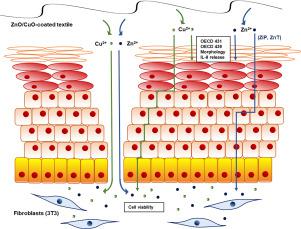当前位置:
X-MOL 学术
›
NanoImpact
›
论文详情
Our official English website, www.x-mol.net, welcomes your
feedback! (Note: you will need to create a separate account there.)
In vitro skin toxicity of CuO and ZnO nanoparticles: Application in the safety assessment of antimicrobial coated textiles
NanoImpact ( IF 4.7 ) Pub Date : 2021-01-01 , DOI: 10.1016/j.impact.2020.100282 Rossella Bengalli 1 , Alessandra Colantuoni 1 , Ilana Perelshtein 2 , Aharon Gedanken 2 , Maddalena Collini 3 , Paride Mantecca 4 , Luisa Fiandra 4
NanoImpact ( IF 4.7 ) Pub Date : 2021-01-01 , DOI: 10.1016/j.impact.2020.100282 Rossella Bengalli 1 , Alessandra Colantuoni 1 , Ilana Perelshtein 2 , Aharon Gedanken 2 , Maddalena Collini 3 , Paride Mantecca 4 , Luisa Fiandra 4
Affiliation

|
Abstract In the context of nosocomial infections, there is an urgent need to develop efficient nanomaterials (NMs) with antibacterial properties for the prevention of infection diseases. Metal oxide nanoparticles (MeO-NPs) are promising candidates for the development of new antibacterial textiles. However, the direct exposure to MeO-NPs and MeO-coated NMs through skin contact could constitute a severe hazard for human health. In this work, the toxicity of copper and zinc oxide (CuO, ZnO) NPs antimicrobial-coated textiles was assessed on an in vitro reconstructed 3D model of epidermis. Thus, MeO-NPs and extracts from MeO-coated NMs were tested on EpiDerm™ skin model according to OECD TG 431 (Corrosion Test) and 439 (Irritation Test), respectively. Skin surface fluids composition is a crucial aspect to be considered in the development of NMs that have to encounter this tissue. So, for the irritation test, coated textiles were extracted in artificial sweat solutions at pH 4.7 and 6.5. Skin tissue viability, pro-inflammatory interleukin-8 secretion and morphological alteration of intermediate and actin filaments of keratinocytes were evaluated after 18 h exposure to extracts from CuO- and ZnO-coated textiles. Analysis of extracts at the two pH conditions indicated that released ions and not NPs are involved in promoting adverse effects on epidermis. Since Cu2+ and Zn2+ ions are known to penetrate epidermis, Balb/3 T3 cells were used as model of dermis. Fibroblasts viability was investigated after the exposure to trans-epidermis permeated ions, collected from EpiDerm™ basal supernatants, and to extracts, as representative of a direct interaction of ions with dermis cells by wounded skin. From our data we can conclude that: 1) skin surface fluids composition is a key parameter for the stability of NPs-coated textiles; 2) MeO ions released from coated textiles can deeply affect the epidermal tissue and the underlying dermal cells upon trans-epidermal permeation; 3) skin barrier integrity is a fundamental prerequisite that should be taken into account during the assessment of NMs safety by direct contact exposure.
中文翻译:

CuO 和 ZnO 纳米颗粒的体外皮肤毒性:在抗菌涂层纺织品安全性评估中的应用
摘要 在医院感染的背景下,迫切需要开发具有抗菌特性的高效纳米材料(NMs)来预防感染性疾病。金属氧化物纳米粒子(MeO-NPs)是开发新型抗菌纺织品的有希望的候选者。然而,通过皮肤接触直接暴露于 MeO-NPs 和 MeO 包覆的 NMs 可能对人类健康构成严重危害。在这项工作中,在体外重建的表皮 3D 模型上评估了铜和氧化锌 (CuO, ZnO) NPs 抗菌涂层纺织品的毒性。因此,分别根据 OECD TG 431(腐蚀测试)和 439(刺激测试)在 EpiDerm™ 皮肤模型上测试了 MeO-NP 和 MeO 包覆的 NM 提取物。皮肤表面液体成分是开发必须遇到该组织的 NM 时要考虑的一个关键方面。因此,对于刺激性测试,涂层纺织品在 pH 4.7 和 6.5 的人造汗液中提取。在暴露于 CuO 和 ZnO 涂层纺织品提取物 18 小时后,评估了皮肤组织活力、促炎性白细胞介素 8 分泌和角质形成细胞中间丝和肌动蛋白丝的形态改变。在两种 pH 条件下对提取物的分析表明,释放的离子而不是 NP 参与促进对表皮的不利影响。由于已知 Cu2+ 和 Zn2+ 离子可穿透表皮,因此使用 Balb/3 T3 细胞作为真皮模型。在暴露于从 EpiDerm™ 基底上清液收集的经表皮渗透的离子后,研究成纤维细胞的活力,和提取物,作为离子与真皮细胞的直接相互作用的代表,受伤的皮肤。从我们的数据我们可以得出结论:1)皮肤表面液体成分是纳米粒子涂层纺织品稳定性的关键参数;2)涂层纺织品释放的MeO离子经表皮渗透后,可对表皮组织及皮下真皮细胞产生深刻影响;3) 皮肤屏障完整性是在通过直接接触暴露评估 NMs 安全性时应考虑的基本先决条件。2)涂层纺织品释放的MeO离子经表皮渗透后,可对表皮组织及皮下真皮细胞产生深刻影响;3) 皮肤屏障完整性是在通过直接接触暴露评估 NMs 安全性时应考虑的基本先决条件。2)涂层纺织品释放的MeO离子经表皮渗透后,可对表皮组织及皮下真皮细胞产生深刻影响;3) 皮肤屏障完整性是在通过直接接触暴露评估 NMs 安全性时应考虑的基本先决条件。
更新日期:2021-01-01
中文翻译:

CuO 和 ZnO 纳米颗粒的体外皮肤毒性:在抗菌涂层纺织品安全性评估中的应用
摘要 在医院感染的背景下,迫切需要开发具有抗菌特性的高效纳米材料(NMs)来预防感染性疾病。金属氧化物纳米粒子(MeO-NPs)是开发新型抗菌纺织品的有希望的候选者。然而,通过皮肤接触直接暴露于 MeO-NPs 和 MeO 包覆的 NMs 可能对人类健康构成严重危害。在这项工作中,在体外重建的表皮 3D 模型上评估了铜和氧化锌 (CuO, ZnO) NPs 抗菌涂层纺织品的毒性。因此,分别根据 OECD TG 431(腐蚀测试)和 439(刺激测试)在 EpiDerm™ 皮肤模型上测试了 MeO-NP 和 MeO 包覆的 NM 提取物。皮肤表面液体成分是开发必须遇到该组织的 NM 时要考虑的一个关键方面。因此,对于刺激性测试,涂层纺织品在 pH 4.7 和 6.5 的人造汗液中提取。在暴露于 CuO 和 ZnO 涂层纺织品提取物 18 小时后,评估了皮肤组织活力、促炎性白细胞介素 8 分泌和角质形成细胞中间丝和肌动蛋白丝的形态改变。在两种 pH 条件下对提取物的分析表明,释放的离子而不是 NP 参与促进对表皮的不利影响。由于已知 Cu2+ 和 Zn2+ 离子可穿透表皮,因此使用 Balb/3 T3 细胞作为真皮模型。在暴露于从 EpiDerm™ 基底上清液收集的经表皮渗透的离子后,研究成纤维细胞的活力,和提取物,作为离子与真皮细胞的直接相互作用的代表,受伤的皮肤。从我们的数据我们可以得出结论:1)皮肤表面液体成分是纳米粒子涂层纺织品稳定性的关键参数;2)涂层纺织品释放的MeO离子经表皮渗透后,可对表皮组织及皮下真皮细胞产生深刻影响;3) 皮肤屏障完整性是在通过直接接触暴露评估 NMs 安全性时应考虑的基本先决条件。2)涂层纺织品释放的MeO离子经表皮渗透后,可对表皮组织及皮下真皮细胞产生深刻影响;3) 皮肤屏障完整性是在通过直接接触暴露评估 NMs 安全性时应考虑的基本先决条件。2)涂层纺织品释放的MeO离子经表皮渗透后,可对表皮组织及皮下真皮细胞产生深刻影响;3) 皮肤屏障完整性是在通过直接接触暴露评估 NMs 安全性时应考虑的基本先决条件。











































 京公网安备 11010802027423号
京公网安备 11010802027423号